War
on weeds
Jack Hobbs reveals
the dark side of plants escaping from gardens, and shows us why
conservation of our native bush needs to start at home.
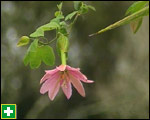 New
Zealand has around 2,400 native plant species. Compare that with
more than 19,000 plants that have been introduced. And more than
2,000 of those have now escaped into the wild and are posing a real
threat to our environment. New
Zealand has around 2,400 native plant species. Compare that with
more than 19,000 plants that have been introduced. And more than
2,000 of those have now escaped into the wild and are posing a real
threat to our environment.
These garden escapees
have become an epidemic in parts of the country. They are aggressive,
reproduce prolifically, spread quickly out of control, and dominate
our native plants.
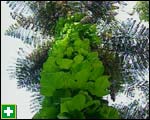 For
example, a pohutukawa has germinated on the trunk of this phoenix
palm up here — and down here, well, another little baby. Neither
of these pohutukawas could have germinated on the foreshore below
because there is a thick carpet of kikuyu grass there. In a lot
of places pohutukawa is not regenerating naturally because an introduced
plant has taken over its habitat. For
example, a pohutukawa has germinated on the trunk of this phoenix
palm up here — and down here, well, another little baby. Neither
of these pohutukawas could have germinated on the foreshore below
because there is a thick carpet of kikuyu grass there. In a lot
of places pohutukawa is not regenerating naturally because an introduced
plant has taken over its habitat.
This is Cornwallis Beach,
one of my absolute favourite regional parks. You can understand
why people built their baches here. While the baches have long gone,
the plants from their gardens remain. In fact, they're doing very
well indeed.
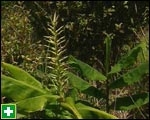 From
here I can see ginger, I can see a loquat. Clambering up a tree,
there's a banana passion fruit — in fact, there's just an awful
lot of stuff. From
here I can see ginger, I can see a loquat. Clambering up a tree,
there's a banana passion fruit — in fact, there's just an awful
lot of stuff.
I'm with Scott De Silva,
senior park ranger with Auckland Regional Council, who says the
news on the weed front is pretty bad, particularly in Auckland.
"Auckland now has become
known as the second worst weed place in the world, behind Hawaii.
I'd say that's probably because of the similar climates we both
have — wet and warm.
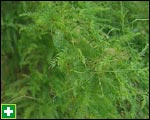 "This
area had a series of baches along here, and a lot of these are garden
escapees. It was settled really early, and people obviously brought
plants to which they were attached and have just let them go wild. "This
area had a series of baches along here, and a lot of these are garden
escapees. It was settled really early, and people obviously brought
plants to which they were attached and have just let them go wild.
"The plants behind us,
for example, these plants have just taken over and the natives are
really struggling."
In this area the worst
weeds are ginger, climbing asparagus and blue morning glory, which
are all hard to control, says De Silva.
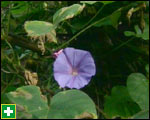 "A
lot of them are replacing areas where natives should be. Their ability
to persist in some of these environments — they've just taken
over. "A
lot of them are replacing areas where natives should be. Their ability
to persist in some of these environments — they've just taken
over.
"Certain ones, like ginger,
can persist under a canopy, and don't require a lot of light. We'll
probably end up with a canopy of mature trees and no regeneration
underneath that. We'll end up with an area full of weeds and very
very few natives."
Looking around, most
of the plants are well-known garden subjects. Agapanthus has spread
down the side of this road, and blue morning glory is creeping over
the top of the trees. The red-berried plant, cotoneaster, is ready
to spread itself everywhere too.
The range of weeds is
enormous. There are ground covers, perennials, climbers, shrubs
and trees. There are shade lovers and sun lovers.
So how do we control
them?
-
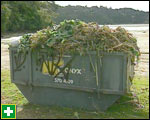 In the Waitakere
Ranges the council has been providing weed bins. When you pull
a weed out of your garden or out of the wild, you can bring it
here, chuck it in the bin, and stop the spread.
In the Waitakere
Ranges the council has been providing weed bins. When you pull
a weed out of your garden or out of the wild, you can bring it
here, chuck it in the bin, and stop the spread.
- Never compost them
because they will bounce back. Don't dump them, either. You saw
what happened in Auckland, the world's second weediest place.
-
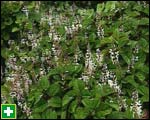 When
you've cleared an area, don't stop there. Once we had an area
here that was covered in ginger. Now it is covered in plectranthus,
which is just about as bad a weed. When
you've cleared an area, don't stop there. Once we had an area
here that was covered in ginger. Now it is covered in plectranthus,
which is just about as bad a weed.
- Plant something once
you've cleared an area of weeds, preferably a vigorous native.
Then a bit of follow-up to keep the weeds at bay until your native
plants have matured.
It's very important that
people look after plants that might escape from their gardens, says
De Silva.
Some of the weeds are
beautiful plants, but the potential of them getting into a park
like this is devastating. Be aware of the potential of these plants,
and if they have the ability to become invasive, watch them like
a hawk.

Reproduced
with permission from NZOOM Home and Garden content,
from the previous
website of 
The views expressed here are not necessarily those of the RNZIH
 |
|
HOME
AND GARDEN |
|
|
More
Garden Articles
|